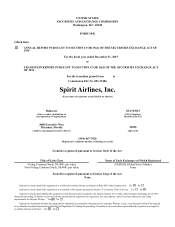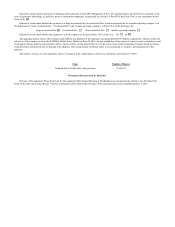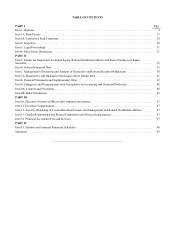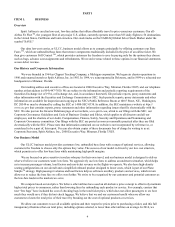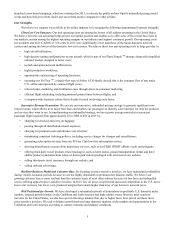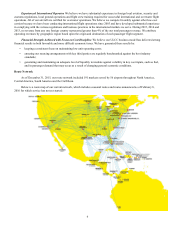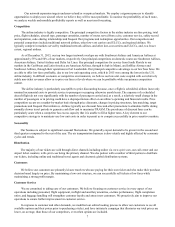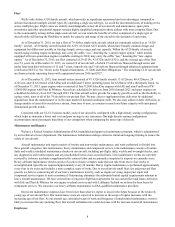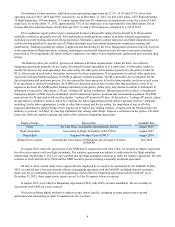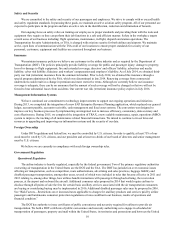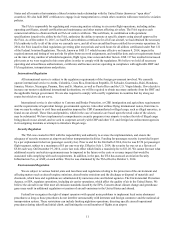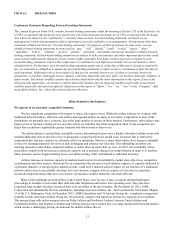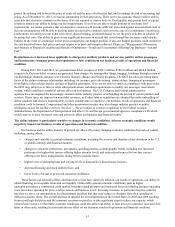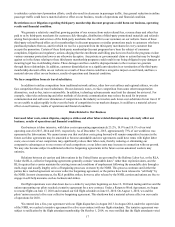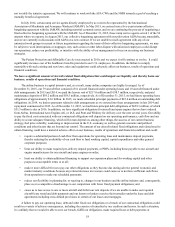Spirit Airlines 2015 Annual Report Download - page 8
Download and view the complete annual report
Please find page 8 of the 2015 Spirit Airlines annual report below. You can navigate through the pages in the report by either clicking on the pages listed below, or by using the keyword search tool below to find specific information within the annual report.8
Fleet
We fly only Airbus A320 family aircraft, which provides us significant operational and cost advantages compared to
airlines that operate multiple aircraft types. By operating a single aircraft type, we avoid the incremental costs of training crews
across multiple types. Flight crews are entirely interchangeable across all of our aircraft, and maintenance, spare parts
inventories and other operational support remains highly simplified compared to those airlines with more complex fleets. Due
to this commonality among Airbus single-aisle aircraft, we can retain the benefits of a fleet comprised of a single type of
aircraft while still having the flexibility to match the capacity and range of the aircraft to the demands of each route.
As of December 31, 2015, we had a fleet of 79 Airbus single-aisle aircraft, which are commonly referred to as “A320
family” aircraft. A320 family aircraft include the A319, A320 and A321 models, which have broadly common design and
equipment but differ most notably in fuselage length, service range and seat capacity. Within the A320 family of aircraft,
models using existing engine technology may carry the suffix “ceo,” denoting the “current engine option,” while models
equipped with new-generation engines (available starting in 2016) may carry the suffix “neo,” denoting the “new engine
option.” As of December 31, 2015, our fleet consisted of 29 A319s, 42 A320s and 8 A321s, and the average age of the fleet
was 5.2 years. As of December 31, 2015, we owned 18 of our aircraft, of which 15 aircraft are financed through senior and
junior long-term debt with terms of 12 and 7 years, respectively, and 3 aircraft are financed through enhanced equipment trust
certificates (EETCs). See “Notes to the Financial Statements—9. Debt and Other Obligations.” The remaining 61 of our aircraft
are financed under operating leases with expirations between 2016 and 2027.
As of December 31, 2015, firm aircraft orders consisted of 87 A320 family aircraft (13 A320ceos, 40 A320neos, 24
A321ceos and 10 A321neos) with Airbus and an additional 5 direct operating leases for A320neos with a third-party lessor. As
of December 31, 2015, spare engine orders consisted of four V2500 SelectOne engines with IAE and nine PurePower PW
1100G-JM engines with Pratt & Whitney. Aircraft are scheduled for delivery from 2016 through 2021 and spare engines are
scheduled for delivery from 2017 through 2023. The firm aircraft orders provide for capacity growth as well as the flexibility to
replace some, none or all of the 79 aircraft in our present fleet. We may elect to supplement these deliveries by additional
acquisitions from the manufacturer or in the open market if demand conditions merit. We also may adjust or defer deliveries, or
change models of aircraft in our delivery stream, from time to time, as a means to match our future capacity with anticipated
demand and growth trends.
Consistent with our ULCC business model, each of our aircraft is configured with a high density seating configuration,
which helps us maintain a lower unit cost and pass savings to our customers. Our high density seating configuration
accommodates more passengers than those of our competitors when comparing the same type of aircraft.
Maintenance and Repairs
We have a Federal Aviation Administration (FAA) mandated and approved maintenance program, which is administered
by our technical services department. Our maintenance technicians undergo extensive initial and ongoing training to ensure the
safety of our aircraft.
Aircraft maintenance and repair consists of routine and non-routine maintenance, and work performed is divided into
three general categories: line maintenance, heavy maintenance and component service. Line maintenance consists of routine
daily and weekly scheduled maintenance checks on our aircraft, including pre-flight, daily, weekly and overnight checks, and
any diagnostics and routine repairs and any unscheduled items on an as needed basis. Line maintenance events are currently
serviced by in-house mechanics supplemented by contract labor and are primarily completed at airports we currently serve.
Heavy airframe maintenance checks consist of a series of more complex tasks that can take from one to four weeks to
accomplish and typically are required approximately every 24 months. Heavy engine maintenance is performed approximately
every four to six years and includes a more complex scope of work. Due to our relatively small fleet size and projected fleet
growth, we believe outsourcing all of our heavy maintenance activity, such as engine servicing, major part repair and
component service repairs is more economical. Outsourcing eliminates the substantial initial capital requirements inherent in
heavy aircraft maintenance. We have entered into a long-term flight hour agreement for our current fleet and future deliveries
with IAE and Pratt & Whitney for our engine overhaul services and with Lufthansa Technik on an hour-by-hour basis for
component services. We outsource our heavy airframe maintenance to FAA-qualified maintenance providers.
Our recent maintenance expenses have been lower than what we expect to incur in the future because of the relatively
young age of our aircraft fleet. Our maintenance costs are expected to increase as the scope of repairs increases with the
increasing age of our fleet. As our aircraft age, scheduled scope of work and frequency of unscheduled maintenance events is
likely to increase like any maturing fleet. Our aircraft utilization rate could decrease with the increase in aircraft maintenance.
Employees

